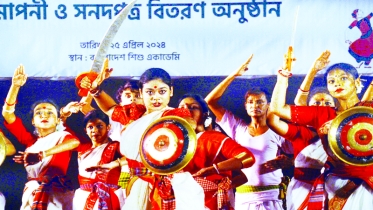(শেষাংশ)
একবিংশ শতাব্দীর প্রথম দশকের শেষ প্রান্তে দাঁড়িয়ে বাঙালী জাতি এদেশের পনেরো কোটি মানুষের প্রগতিশীল আশা আকাক্সক্ষা যদি বাস্তবায়ন করতে চায় তাহলে এদেশে শান্তি ও সমৃদ্ধি লাভের যে নতুন সুযোগ সৃষ্টি হয়েছে তার সার্বিক সদ্ব্যবহার করতে হবে। এর জন্য প্রয়োজন অর্থনৈতিক, রাজনৈতিক ক্রিয়াকর্মে জনগণের সক্রিয় স¤পৃক্তি। গণতন্ত্র ও মানবাধিকারের পূর্ণ বাস্তবায়ন এ দেশের উন্নয়নের সঠিক মাপকাঠি। প্রতিটি নাগরিকের মৌলিক অধিকার নিশ্চিতকরণ ও সকল নাগরিকের জন্যে আইনের শাসন, মৌলিক মানবাধিকার এবং রাজনৈতিক, অর্থনৈতিক ও সামাজিক ন্যায়বিচার, এ দেশের মানুষের প্রজন্ম-পর¤পরায় সাংবিধানিক প্রত্যাশা। সাম্য, স্বাধীনতা মানবিক মর্যাদা ও সুবিচার আমাদের স্বাধীনতার অঙ্গীকার। এ সব কিছুর অর্জন বাংলাদেশের উন্নয়নের মূল লক্ষ্য। জনগণের ক্ষমতায়নের মাধ্যমেই এই লক্ষ্য বাস্তবায়ন সম্ভব। মানবাধিকার বিকাশের মাঝেই বাংলাদেশের সৃষ্টি, মানবাধিকার প্রতিষ্ঠার মাধ্যমেই বাংলাদেশের স্থিতি এবং মানবাধিকারের প্রকৃত বাস্তবায়নের মাধ্যমেই বাংলাদেশের সমৃদ্ধি ও প্রগতি।
বাংলাদেশের স্বাধীনতা ও মুক্তির সনদ স্বাধীনতার ঘোষণাপত্র ও বাংলাদেশের সংবিধানের প্রতি আন্তরিক ও অকৃত্রিম আনুগত্যই শুধু পারে এদেশবাসীকে দলমত নির্বিশেষে ঐক্যবদ্ধ করতে। এমন একটি ঐক্যই শুধু পারে সম্ভাবনাময় বাংলাদেশকে উন্নয়নের শিখরে পৌঁছাতে।
সংযুক্তি কপি: অষ্টম সংশোধনী মামলায় বিচারপতি সাহাবুদ্দীনের রায়ের অংশবিশেষ
325. Yakub Ali, J. In Asma Jilani V. Government of Punjab (1972) PLD SC 139 while tracing the genesis of Pakistan’s Constitutional problems said that the mishaps started in 1953 when the Governor General arbitrarily dismissed the Government of Prime Minister Khawaja Nazimuddin. No, the Constitutional mishaps started much earlier, even before the birth of Pakistan. Election battle of Pakistan was fought on the basis of the Lahore Resolution of the All India Muslim League adopted by its Council on 23 March 1940 which envisaged two States in the contiguous Muslim majority Provinces of India, one in the North-Western Win and the other in the North Eastern Wing. But just after election battle was won on this issue, the word ‘State’ in the Lahore Resolution was found replaced by the word ‘State’, in a mysterious way. Consequently, the two geographical areas separated from each other by over a thousand miles were constituted into one single State. The Eastern Wing, East Bengal, contained in the majority population of the country but this majority, instead of becoming a boon brought trouble and sorrow for her. The Constituent Assembly consisted of 77 members, 44 from East Bengal and 35 from West Pakistan. But East Bengal gave up five seats in favour of the Muslim League leaders, including Liakat Ali Khan, Prime Minister, who had migrated to Pakistan from Indian Dominion. These five members, officially representing East Bengal, never identified with East Bengal, her interest, hopes and sentiments, but all of them settled in the Western Wing and consequently East Bengal’s majority in the Constituent Assembly was neutralized.
326. The Objectives Resolution passed by the Constituent Assembly on 7th March, 1949 contained the Fundamental Principles of the State, the first among them being “the principles of democracy, freedom, equality, tolerance and social justice as enunciated by ‘Islam’ shall be fully observed”. Of this principle only the word ‘Islam’ was left in the lips of the Leadership to be uttered on and off giving a go-by to the rest of the principle. In April 1953 the West Pakistani Governor General dismissed the Bengali Prime Minister although he had almost cent per cent majority in the Parliament, and when the Bengalee members of the Parliament-cum-Constituent Assembly were going to assert their majority in the House to frame a Constitution on democratic principles, the Governor General dissolved the Constituent Assembly itself though he as a mere representative of the British Crown, had no power whatever to do so. Speaker of the Constituent Assembly, Mvi. Tamizuddin Khan challenged this autocratic action of the Governor General in the Sind Chief Court by a Writ Petition and got a favourable verdict which declared the Governor General’s action illegal, unconstitutional and arbitrary. Governor General preferred an appeal to the Federal Court which was presided over by a Punjabi Chief Justice. There a lame excuse was found to undo the decision of the Chief Court. It was that the Writ Petition itself was not maintainable as Section 223(2) of the Government of India Act, as adopted in Pakistan, under which the Writ Petition was invoked by Mvi. Tamizuddin Khan was invalid as it did not receive the Governor General’s assent. Cornelius, J. who dissented from the majority Judgment of the Court held that Governor General not being a part of the Constituent Assembly, his assent to any Constitutional law was not at all necessary; he pointed out that 38 such Constitutional laws enacted by the Constituent Assembly since 1947 did not receive assent of the Governor General but were acted upon without any question. By majority Judgment the Federal Court set aside the Chief Court’s decision and dismissed the writ petition upholding the arbitrary action of the Governor General who continued to rule the country in autocratic fashion, fully backed by West Pakistan military, civil bureaucracy, landed aristocracy and industrial and business magnets.
327. A Constitution was ultimately enacted in 1956 only when East Pakistan surrendered her claim to majority and accepted ‘parity’ between the two Wings in all respects. But before this Constitution was given a fair trial, it was abrogated in 1958 by a military coup led by the then C-In-C (General Ayub Khan) and the country was ruled by Martial law for about four years. In 1962 Gen. Ayub Khan, who in the meantime, declared himself President of the Country and Field Marshal of the army enacted a Constitution which denied the people their democratic right of adult franchise and made the “basic democrats-grass-root local bodies– the electorate for election to Palriament and Provincial Assemblies and consequently the country continued to be ruled by civil and military bureaucrats of West Pakistan. Even this Constitution did not last long. In march 1969 Gen. Yahya Khan, Army Chief, abrogated it, imposed Martial Law and declared himself President of the Country. During this Martial Law he arranged a General Election to Parliament – the first and the last General Election ion Pakistan – the members of which were to frame a new Constitution. Result of the election went in favour of the Awami League which proceeded to frame a Constitution on the basis of its Six point programme which envisaged full autonomy to the Provinces and a Federal Government with only three subjects. Leaders of West Pakistan both civil and military did not like any such Constitution to be framed; political turmoil followed and while negotiation was going on between Government and East Pakistan leaders for apolitical settlement, Yahya Khan and his military treacherously declared war on the unarmed people of East Pakistan and started the worst genocide in history. Thus the war began which ended in Independent Bangladesh, which was established solely for establishing a Democratic polity.








